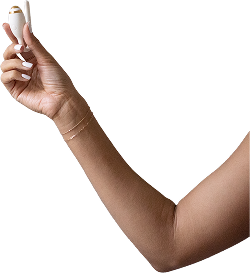1. What factors can impact my kegg readings?
- It is important to take your readings around the same time each day, within the same 2-hour window. If you cannot use kegg during your 2-hour window, it is better to skip kegg use for that day.
- kegg needs consistent daily readings. Try to use kegg daily as much as possible!
- Ensure that you are not using kegg within 8-hours after intercourse.
- Some medications and supplements can impact your electrolytes, and therefore impact your kegg readings.
- Bacterial infections, yeast infections, and UTIs can skew readings.
- For kegg to provide useful insights, the user must menstruate and ovulate regularly. When you get your period, be sure to enter it into the kegg app.
- Be sure you meet the criteria for kegg use. You can read the kegg manual here
2. What is my kegg chart showing me?
kegg displays your predicted fertile window in green. The kegg readings typically look like a valley during the fertile window. As ovulation approaches, estrogen rises, and the cervical mucus becomes more hospitable to sperm. This results in a downward trend in kegg data. After ovulation when progesterone is released, there is a rise in kegg readings. Before and after the fertile window there can be quite a variation in normal readings. It is typical to see fluctuations in readings even after ovulation. Readings do not need to remain elevated after the fertile valley. There are many variations in what a typical fertile window will look like. It can be a very slight valley, a slow progression down, a more deep descent, and several other variations which are all normal. Please note: kegg can detect even the slightest changes in readings, and therefore continue to recognize your trend even if it is not very apparent to the user.
3. My fertile window does not appear to “dip” deeply into a valley.
Some kegg charts will have very obvious valleys during the fertile window while other charts will have less obvious fluctuations. Fortunately, kegg is able to read and evaluate even these small changes and put its intelligent algorithm to work even when your data might appear fairly flat.
4. My luteal phase values don’t remain high. Does this mean I have a problem?
This is very common and does not indicate fluctuating or declining levels of progesterone. Unlike temps, kegg values do not need to remain high until your next cycle. Valleys and hills during the luteal phase are very common.
5. My values are rising before my fertile window! What does this mean?
This is very common. Typically the fertile window is sandwiched between two peaks. You may see climbing values in the follicular (pre-ovulatory) phase before the descent as you approach your fertile window. This is a good indicator you are approaching your fertile window.
6. Is kegg supposed to measure my temperature?
No, kegg records electrolyte readings (cervical mucus) only and not temperatures. You can record your basal body temperatures by your preferred method and enter this information manually into the kegg app in your daily fertility notes if you wish to track this information. To view the temperatures you input into the app, tap the thermometer on the top left part of the screen when looking at your chart.
7. I am not getting a fertile window prediction or period prediction. What happened?
If your cycles are longer than 40 days and shorter than 21, kegg will not formulate a green fertile window prediction at this time. The good news is that even with long cycles users can still typically see a fertile valley with consistent readings and not need the prediction.
Is this your first cycle with kegg? If so, did you input your average cycle length at start-up? Alternatively, you can enter a couple of previous periods in the calendar. Kegg requires cycle length information for your first cycle as it learns your trends.ň
8. I only want to use my kegg during my fertile window. Is that ok?
No, use kegg daily! Consistency is key.
For accurate results, kegg needs to be used daily throughout the duration of each cycle, with the exception of during your period. kegg uses trends to make its predictions. There is not one electrolyte value or range that correlates with the fertile window and these values can fluctuate between cycles and vary among women. Instead, it is the fluctuations within the cycle that help kegg (and you!) identify this window. As a result, kegg needs consistent readings leading up to, during, and after the fertile window.
9. I just had a baby and kegg is not giving me predictions for when my period will return. What should I do?
kegg relies on trend data which it needs to collect during your first cycle with kegg. kegg will not provide fertile window predictions for cycle lengths greater than 40 days and requires the input of a period with each cycle. If you are not breastfeeding or pumping, we recommend waiting at least 6 weeks postpartum to use kegg and until you have had at least two full cycles in the postpartum period. If you are breastfeeding or pumping, wait to use kegg until two full cycles have passed once you stop breastfeeding or pumping. Even if you are cycling regularly while producing milk, the hormone prolactin which is responsible for milk production can impact kegg readings.
Please speak with your doctor about when it is safe for you to resume kegg use in the postpartum period.
Please speak with your doctor about when it is safe for you to resume kegg use in the postpartum period.
10. Why does kegg not predict when I will ovulate?
kegg is designed to predict your fertile window, when your cervical mucus will be most hospitable to sperm to possibly result in conception. The fertile window occurs on the days leading up to ovulation through the day after ovulation typically. Identifying the full fertile window helps women maximize their chances.
11. Why does kegg not display numerical data?
kegg measures the electrolytes level and their shifts that happen when the fertile window is about to open and close, through impedance of the cervical fluid in ohms. Impedance can be expressed in ohms or in siemens. The absolute number in each kegg’s reading is not a physiological measurement like heart rate or temp . The impedance of cervical fluid changes with hormonal shifts through the cycle. There is no set number or range that indicates high or low fertility as these values vary among women and even cycle to cycle for the individual. For this reason the exact number of ohms will not be useful information to the average user. Whether a reading is 340.5 or 627 makes no difference. It’s the full picture and pattern of readings that is important. What kegg is looking for is a trend of lower values that eventually rise. Some cycles have very obvious fertile valleys while others can be very subtle. It’s the trend that matters (which is why you should use kegg every day when not on your period).
We understand some users would like to see the numbers so they can chart it themselves in other programs or on paper. We’re adding some features to the app that makes seeing the trend more and more useful, stay tuned!
12. Where can I learn more?
For more commonly asked questions, please visit our FAQ. Check out our blog! We have many helpful resources about reading charts, fertility, and even pregnancy kegg charts. To visit our blog, click here.
Have you joined our private Facebook group? Here many users share their charts. Our kegg team of experts also provide insights. Join our supportive group of keggsters on Facebook.
Do you still have questions? Contact our customer support team.
Do you still have questions? Contact our customer support team.
13. I love my kegg! How can I spread the word?
We are thrilled to hear that! Thank you for helping spread the word about kegg! Please share your review on our website as this is very helpful to other women who are also on their fertility journeys.



